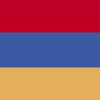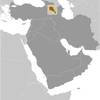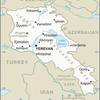Armenia [+]Compare [E]dit [H]istory
Aliases: Armenian Republic, Armenian Soviet Socialist Republic, Hayastan, Hayastani Hanrapetut'yun, Republic of ArmeniaObject «Armenia» was created due to
Add new object to «Armenia» or move existing objects here.
Object «Armenia» has attributes [Show empty attributes][Hide empty attributes]
| Attribute | Value |
|---|---|
| Geography | |
| Area | 29,743 km² |
| Continent | Asia |
| Land area | 28,203 km² |
| Water area | 1,540 km² |
| Land boundaries | 1,570 km |
| Border countries |
|
| Coastline | 0 km |
| Mean elevation | 1,792 m |
| Lowest point | 400 m |
| Highest point | 4,090 m |
| People | |
| Population | 3,021,324 |
| Official languages |
|
| Religion | Armenian Apostolic |
| Government | |
| Long country name | Republic of Armenia |
| Short country name | Armenia |
| Long local name | Hayastani Hanrapetut'yun |
| Short local name | Hayastan |
| Former name |
|
| Government type | Parliamentary democracy |
| Capital | Yerevan |
| Economy | |
| GDP (PPP) | 28,340,000,000 USD |
| GDP (OER) | 11,540,000,000 USD |
| GDP (real growth rate) | 7.5 % |
| GDP - per capita (PPP) | 9,500 USD |
| Gross national saving | 17.8 % of GDP |
| Labor force | 1,507,000 |
| Unemployment rate | 18.9 % |
| Population below poverty line | 32 % |
| Budget revenues | 2,644,000,000 USD |
| Budget expenditures | 3,192,000,000 USD |
| Military expenditures | 4.25 % of GDP |
| Taxes and other revenues | 22.9 % of GDP |
| Budget surplus or deficit | -4.8 % of GDP |
| Public debt | 53.5 % of GDP |
| Inflation rate | 0.9 % |
| Central bank discount rate | 6.5 % |
| Commercial bank prime lending rate | 14.41 % |
| Stock of narrow money | 1,629,000,000 USD |
| Stock of broad money | 1,629,000,000 USD |
| Stock of domestic credit | 6,712,000,000 USD |
| Market value of publicly traded shares | 132,100,000 USD |
| Current account balance | -328,000,000 USD |
| Exports | 2,361,000,000 USD |
| Imports | 3,771,000,000 USD |
| Reserves of foreign exchange and gold | 2,314,000,000 USD |
| External debt | 10,410,000,000 USD |
| National currency | drams |
| National currency (code) | AMD |
| National currency (symbol) | Add |
| National currency rate to USD | 487.9 |
Armenia prides itself on being the first nation to formally adopt Christianity (early 4th century). Despite periods of autonomy, over the centuries Armenia came under the sway of various empires including the Roman, Byzantine, Arab, Persian, and Ottoman. During World War I in the western portion of Armenia, the Ottoman Empire instituted a policy of forced resettlement coupled with other harsh practices that resulted in at least 1 million Armenian deaths. The eastern area of Armenia was ceded by the Ottomans to Russia in 1828; this portion declared its independence in 1918, but was conquered by the Soviet Red Army in 1920. Armenia remains involved in the protracted Nagorno-Karabakh conflict with Azerbaijan. Nagorno-Karabakh was a primarily ethnic Armenian region that Moscow recognized in 1923 as an autonomous oblast within Soviet Azerbaijan. In the late Soviet period, a separatist movement developed which sought to end Azerbaijani control over the region. Fighting over Nagorno-Karabakh began in 1988 and escalated after Armenia and Azerbaijan attained independence from the Soviet Union in 1991. By the time a ceasefire took effect in May 1994, separatists, with Armenian support, controlled Nagorno‑Karabakh and seven surrounding Azerbaijani territories. The 1994 ceasefire continues to hold, although violence continues along the line of contact separating the opposing forces, as well as the Armenia-Azerbaijan international border. The final status of Nagorno-Karabakh remains the subject of international mediation by the Organization for Security and Cooperation in Europe (OSCE) Minsk Group, which works to help the sides settle the conflict peacefully. The OSCE Minsk Group is co‑chaired by the US, France, and Russia. Turkey closed the common border with Armenia in 1993 in support of Azerbaijan in its conflict with Armenia over control of Nagorno-Karabakh and surrounding areas, further hampering Armenian economic growth. In 2009, Armenia and Turkey signed Protocols normalizing relations between the two countries, but neither country ratified the Protocols, and Armenia officially withdrew from the Protocols in March 2018. In 2015, Armenia joined the Eurasian Economic Union alongside Russia, Belarus, Kazakhstan, and Kyrgyzstan. In November 2017, Armenia signed a Comprehensive and Enhanced Partnership Agreement (CEPA) with the EU. In spring 2018, Serzh SARGSIAN of the Republican Party of Armenia (RPA) stepped down and Civil Contract party leader Nikol PASHINYAN became prime minister.
Similar objects
Most often compared with
Everyone can something to edit or add.
There were 3 edits, no edits waiting approval. Last edited by ciara11(4637), Sep 14, 2019 (one field was changed)
Help · Contact us · Disclaimer · Contributors · Developers · Donate


